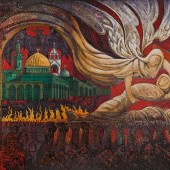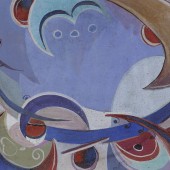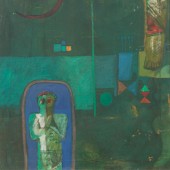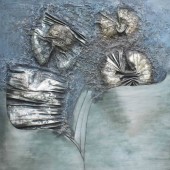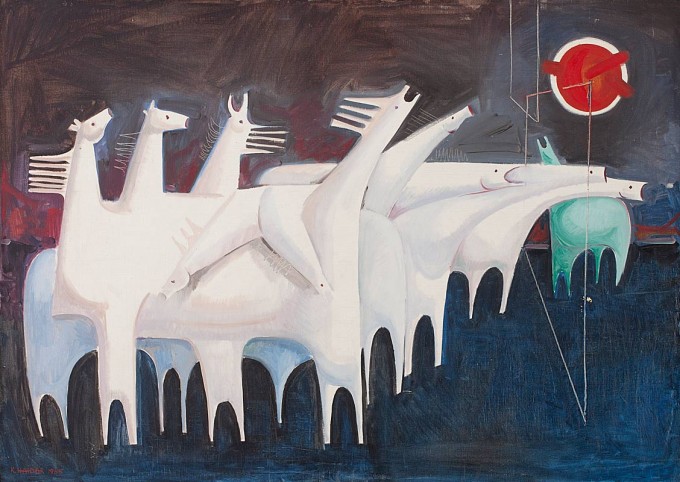
Ten mythical white horses, their abstracted bodies collapsed together in grief, wail out to a bare, nocturnal landscape. An isolated green horse turns his body away from the group, exiled under a blood red moon. This painting is from one of Iraqi artist Kadhim Hayder’s most notable series, The Epic of the Martyr, based on a poem the artist wrote in 1965, and exhibited that year at the new National Museum of Modern Art in Baghdad. The poem references the eighth century Battle of Karbala, which resulted in the death of the Prophet Mohammad’s grandson, Hussein Ibn Ali; an event that is commemorated annually through public mourning rituals. The work references this significant moment of martyrdom in Islamic history as an allegory for the tumultuous and rapidly transforming political context of Iraq following the 1963 coup in which many suspected dissidents and political opponents were killed. According to the artist Dia Azzawi, Hayder introduced in this series a new paradigm in Iraqi modernism by drawing on history and cultural memory as motifs, isolated from direct narrative reference, that served as allegories for the present.
An artist, writer, and poet, Hayder is a revered figure in Iraq’s modernist movement and was involved in a number of artists’ collectives during the 1950s and 1960s. Hayder studied literature at the University of Baghdad and theatre design at London’s Royal College of Arts in the early 1960s. He exhibited frequently in the 1970s, including at Baghdad’s First Arab Biennial in 1974. Hayder died in Baghdad, Iraq, in 1985.
تصوّر اللوحة عشرة خيول بيضاء أسطورية، تجتمع أجسادها المجردة معاً باكيةً في حزن وأسى ضمن مشهد ليلي كئيب. ويوجد حصان أخضر منعزل عن الأحصنة الأخرى، منفياً تحت قمر ذو لون أحمر دموي. وتندرج هذه اللوحة ضمن سلسلة “ملحمة الشهيد” الشهيرة، وهي مستوحاة من قصيدة كتبها الفنان بنفسه عام 1965، وقد تم عرضها في العام ذاته في “المتحف الوطني للفن الحديث” في بغداد. وتشير القصيدة إلى واقعة كربلاء التي حدثت في القرن الثامن، والتي أسفرت عن استشهاد حفيد النبي محمد (ص) الإمام الحسين بن علي (عليه السلام)؛ وهي ذكرى يتم إحياؤها سنوياً من خلال طقوس حداد عامة. ويشير العمل إلى هذه الحادثة التي تركت أثراً كبيراً في التاريخ الإسلامي، كقصةٍ رمزية للبيئة السياسية المضطربة والمتقلبة في العراق في أعقاب انقلاب عام 1963، والذي قتل فيه العديد من المعارضين والمُنشقين المشتبه بهم.
ووفقاً للفنان ضياء العزاوي، فقد قدّم حيدر في هذه السلسلة نموذجاً جديداً في الحداثة العراقية من خلال اعتماد التاريخ والذاكرة الثقافية كمواضيع أساسية للعمل بعيداً عن الأسلوب السردي المباشر، واستخدامها كرموز للحاضر.
ويعتبر الفنان والكاتب والشاعر حيدر شخصيةً مرموقةً في حركة الحداثة في العراق، وقد شارك في عدد من الجمعيات الفنية خلال فترة الخمسينيات والستينيات. درس حيدر الأدب في جامعة بغداد، وفن التصميم المسرحي في “الكلية الملكية للفنون” في لندن في مطلع الستينيات. وأقام حيدر العديد من المعارض المتكررة خلال فترة السبعينيات، بما في ذلك بينالي العرب الأول في بغداد عام 1974. توفي كاظم حيدر في بغداد، العراق، عام 1985.




